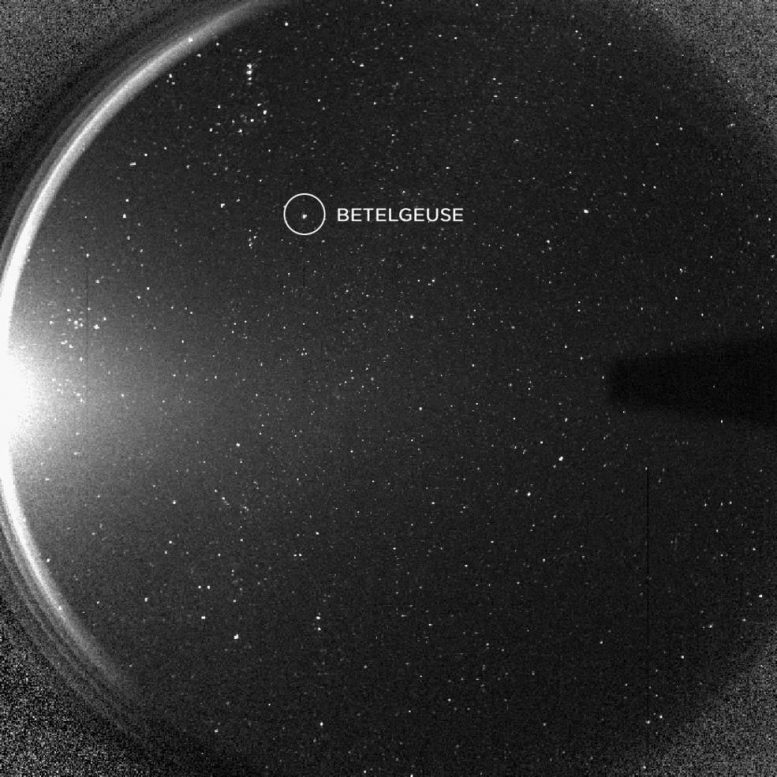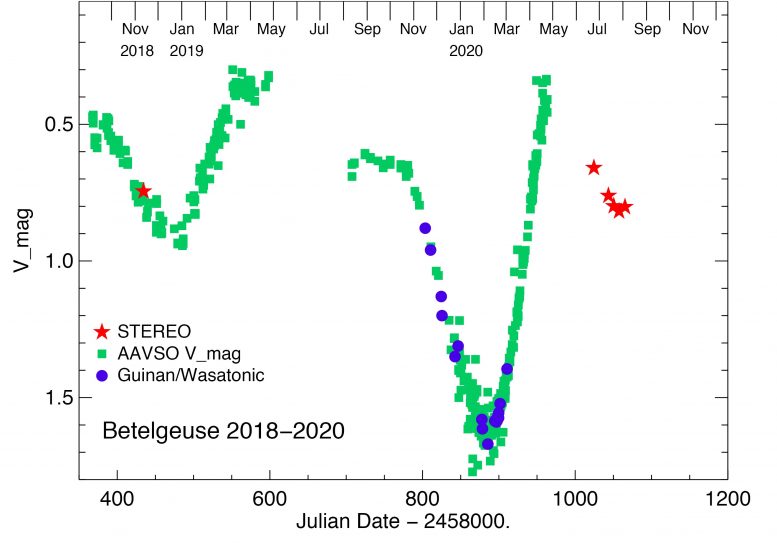
An image from the Heliospheric Imager aboard NASA’s STEREO spacecraft shows the star Betelgeuse, circled. For several weeks in 2020, STEREO was the only observatory making measurements of Betelgeuse because of the spacecraft’s unique position in space. Credit: NASA/STEREO/HI
For several weeks in summer 2020, NASA’s Solar and Terrestrial Relations Observatory, or STEREO, had the solar system’s best view of the star Betelgeuse, whose extreme dimming over the past several months has intrigued scientists. STEREO’s measurements revealed more unexpected dimming by the star, further adding to the questions around Betelgeuse’s recent behavior.
Starting in late spring 2020, Betelgeuse has appeared close to the Sun in the sky because of Earth’s position in space. However, the STEREO spacecraft is currently about 70 degrees away from Earth — meaning that in late June, STEREO was in approximately the same position that Earth was in around mid-April, and could therefore see the stars that appeared in Earth’s night sky during April.

This figure shows measurements of Betelgeuse’s brightness from different observatories from late 2018 to present. The blue and green points represent data from ground-based observatories. The gaps in these measurements happen when Betelgeuse appears in Earth’s day sky, making it impossible to take precise brightness measurements. During this observation gap in 2020, NASA’s STEREO spacecraft — with measurements shown in red — stepped in to observe Betelgeuse from its unique vantage point, revealing unexpected dimming by the star. The 2018 data point from STEREO was found in the mission’s archival data and was used to calibrate STEREO’s measurements against other telescopes. Credit: Dupree, et al
Scientists took advantage of this unique orbital position to keep tabs on Betelgeuse while the star was invisible to Earth-bound observatories. During this period between late June and early August, STEREO observed Betelgeuse on five separate days, rolling the spacecraft for about two hours each time to place Betelgeuse in the field of view of STEREO’s Heliospheric Imager, an instrument usually used to capture images of the Sun’s outflowing material, the solar wind, as it passes by the spacecraft and towards Earth. The team shortened the instrument’s exposure time to account for Betelgeuse’s relative brightness compared to the solar wind. The instrument’s wide field of view covers about 70 degrees of sky, which allowed scientists to calibrate their measurements using steady stars in the night sky across several weeks.
STEREO’s measurements revealed that Betelgeuse is dimming again — an unexpected development so soon after its last dim period. Betelgeuse typically goes through brightness cycles lasting about 420 days, with the previous minimum in February 2020, meaning this dimming is happening unexpectedly early. These observations were reported by the science team via The Astronomer’s Telegram on July 28, 2020. This is an intriguing phenomenon that scientists will study with additional Earth-orbiting and ground-based observatories when Betelgeuse returns to the night sky in late August.

This four-panel graphic illustrates how the southern region of the rapidly evolving, bright, red supergiant star Betelgeuse may have suddenly become fainter for several months during late 2019 and early 2020. In the first two panels, as seen in ultraviolet light with the Hubble Space Telescope, a bright, hot blob of plasma is ejected from the emergence of a huge convection cell on the star’s surface. In panel three, the outflowing, expelled gas rapidly expands outward. It cools to form an enormous cloud of obscuring dust grains. The final panel reveals the huge dust cloud blocking the light (as seen from Earth) from a quarter of the star’s surface. Illustration credit: NASA, ESA, and E. Wheatley (STScI)
Is a Supernova Imminent?
The red supergiant is destined to end its life in a supernova blast. Some astronomers think the sudden dimming may be a pre-supernova event. The star is relatively nearby, about 725 light-years away, which means the dimming would have happened around the year 1300. But its light is just reaching Earth now.
“No one knows what a star does right before it goes supernova, because it’s never been observed,” Andrea Dupree, associate director of the Center for Astrophysics | Harvard & Smithsonian (CfA), Cambridge, Massachusetts, explained. “Astronomers have sampled stars maybe a year ahead of them going supernova, but not within days or weeks before it happened. But the chance of the star going supernova anytime soon is pretty small.”
Read Hubble Finds Cause for Betelgeuse’s Mysterious Dimming for more research on Betelgeuse’s recent dimming.
"behavior" - Google News
August 15, 2020 at 05:22PM
https://ift.tt/3kJpCQi
NASA STEREO Spacecraft’s Lone View of Betelgeuse Reveals More Strange Behavior – Is Supernova Imminent? - SciTechDaily
"behavior" - Google News
https://ift.tt/2We9Kdi
Bagikan Berita Ini















0 Response to "NASA STEREO Spacecraft’s Lone View of Betelgeuse Reveals More Strange Behavior – Is Supernova Imminent? - SciTechDaily"
Post a Comment